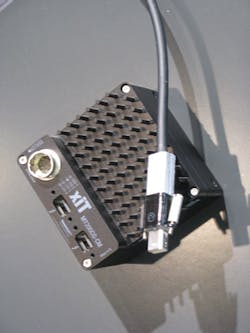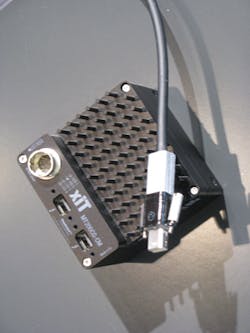Camera Interfaces: Camera vendors introduce Thunderbolt products at VISION 2014
One of the ways camera manufacturers distinguish their products is the type of camera-to-computer interface that is used. Whether it is Camera Link, Camera Link HS, USB 3 Vision, GigE Vision, 10 GigE Vision or CoaXPress (CXP), the different throughputs, cable lengths, I/O features and power-over-cable capability of these interfaces must be carefully considered when specifying a camera for machine vision.
While Camera Link, Camera Link HS and CXP have been specifically designed to address the needs of machine vision developers, other standards such as GigE Vision and USB 3 Vision leverage technology primarily developed for the general purpose computer industry.
With maximum data transfer rates specified at 1Gbit/s and 5Gbits/s respectively, the GigE Vision and USB 3 Vision standards offer a way for developers to configure systems without using a frame grabber.
For higher data transfers, cameras and frame grabbers incorporating the CXP standard allow data transfer rates of 25 Gbit/s when using four channel links.
Recognizing the need for a low-cost means to increase the data transfer rate without the need for frame grabbers, two camera vendors - Allied Vision (Stadtroda, Germany; www.alliedvision.com) and Ximea (Munich, Germany; www.ximea.com) - recently demonstrated cameras based on the Thunderbolt standard co-developed by Apple Computer (Cupertino, CA; www.apple.com) and Intel (Santa Clara, CA; www.intel.com).
Like USB 3 and Ethernet, the Thunderbolt standard is a general purpose computer interface that allows external peripherals to be interfaced to a PC. Four independent 10Gbps channels are used in the Thunderbolt interface to accommodate the send and receive channels used from PCIe or DisplayPort devices. These are then multiplexed over the cable using a Thunderbolt controller IC.
While the first incarnation of Thunderbolt can transfer data at 10Gbps, Thunderbolt 2, combines the two previously separate 10Gbps channels together thus providing two 20Gbps bi-directional channels.
While many camera manufacturers may choose to wait to implement the 10Gbps USB 3.1 standard, Ximea introduced two cameras based on the technology at last year's VISION show in Stuttgart. While the first, the MT200MG/CG is based on the 5120 x 3840x 12-bit CMV 2000 CMOS imager from CMOSIS (Antwerp, Belgium; www.cmosis.com) that runs at 32 fps, the second camera, the MT023MG/CG is based on the IMX174, a 1936 x 1216 imager from Sony (Tokyo, Japan; www.sony.com) that runs at 165 fps.
Like Ximea, Allied Vision also showed a Thunderbolt-based camera at the show. Still a prototype, the company was hesitant to release technical details about the camera. Indeed, in a document handed to attendees, the company was asking developers what they thought of the interface in terms of speed, real-time triggering capability, and the Thunderbolt standard's 10W power delivery and 3m (electrical) and 100m (optical) cable length.
While still in its infancy - at least for developers of machine vision systems - much work needs to be done before Thunderbolt can compete as a machine vision standard according to Thomas Detjen, Head of Sales and Marketing at Alysium-Tech (Nuremberg, Germany; www.alysium-tech.com), a company that has already developed cables and connectors for the interface.
Although Apple Computer specifies that the connector is manufactured of plastic and uses no screw connectors, machine vision systems may demand a more rugged die cast connector with screw connectors. To date, neither such a connector nor a specification exists for the screw distances that might be used.
When asked whether he thought Thunderbolt would become another standard that systems integrators should choose in their next designs, Ray Berst, President of Components Express Inc. (CEI; Woodridge, IL, USA; www.componentsexpress.com) was more philosophical.
"Do we really need another standard based on a general purpose product? Wouldn't it be better to develop a standard solely for the machine vision industry?"
Needless to say, many others at the VISION show agreed.

